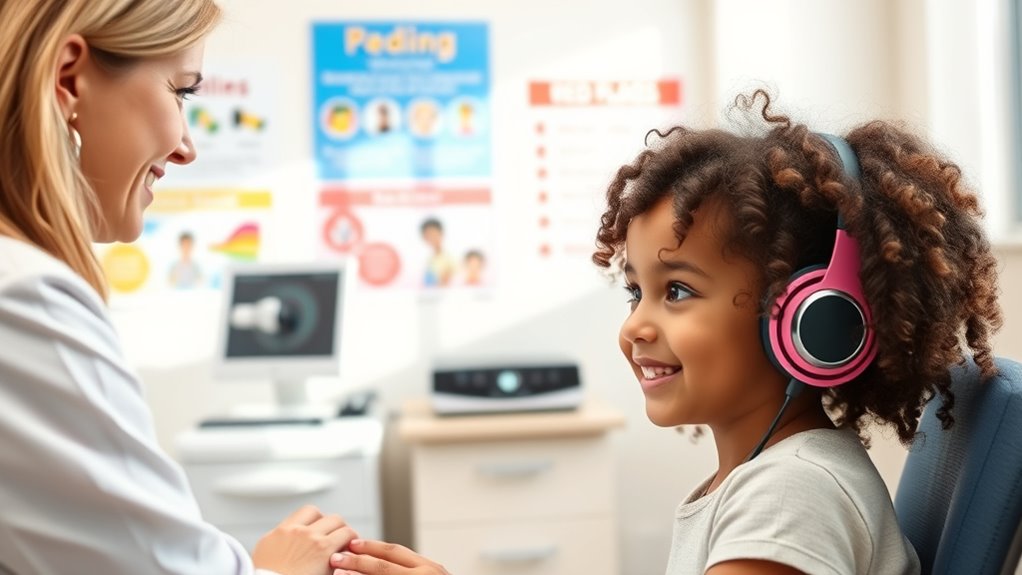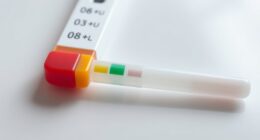To check your child’s hearing health, watch for milestones like responding to sounds by 6-12 months, speaking simple words around age 2, and following directions. Red flags include ignoring loud noises, speech delays, limited vocabulary, and inconsistent responses. Common causes of hearing issues include infections, noise exposure, or structural concerns. Monitoring responses and scheduling regular checkups help catch issues early. Keep exploring to learn more about supporting your child’s hearing development and addressing concerns early.
Key Takeaways
- Early sound responses, like startling or turning toward sounds, are signs of healthy hearing in infants.
- Milestones such as babbling by 6-12 months and forming short sentences by age 2-3 indicate typical development.
- Red flags include missed milestones, lack of response to sounds, speech delays, or frequent ear infections.
- Routine screenings like otoacoustic emissions and audiometry help detect hearing issues early.
- Behavioral cues like asking for repetition or limited vocabulary can signal hearing concerns in preschool children.
Recognizing Early Sound Response in Infants
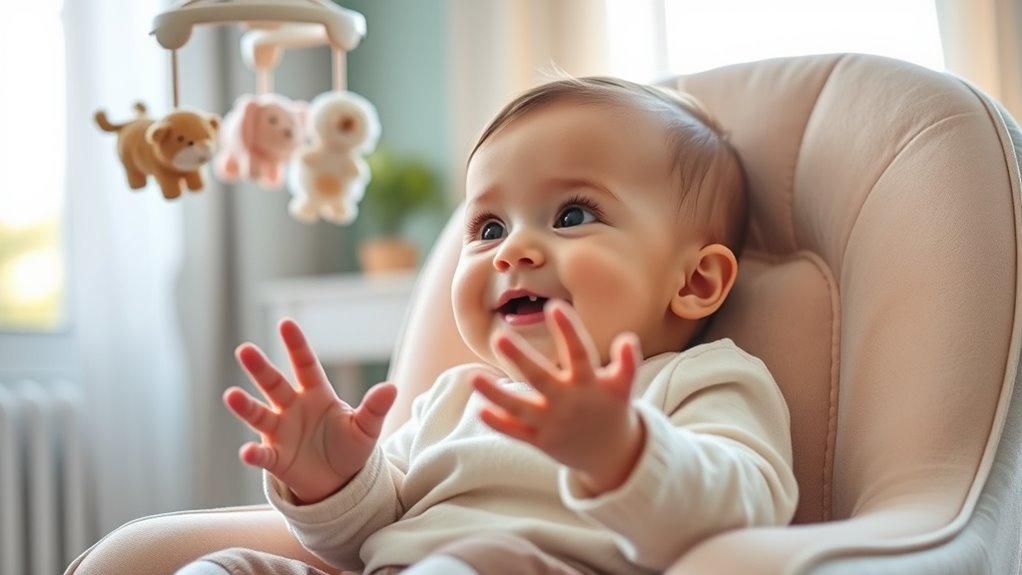
Since infants begin to respond to sounds early on, recognizing these reactions is vital to identifying potential hearing issues. You should observe how your baby reacts to loud noises, voices, or familiar sounds. For example, if they startle, turn their head, or stop their activity when they hear a sound, it indicates they’re hearing. Consistent responses to auditory stimuli are signs of healthy hearing. Conversely, if your baby ignores sounds or shows no reaction, it could be a red flag. Early detection is essential because hearing problems can impact speech development later on. Pay attention to these early responses, and discuss any concerns with your pediatrician promptly. Recognizing how your infant responds helps guarantee they receive timely assessments and support if needed.
Milestones in Speech and Language Development
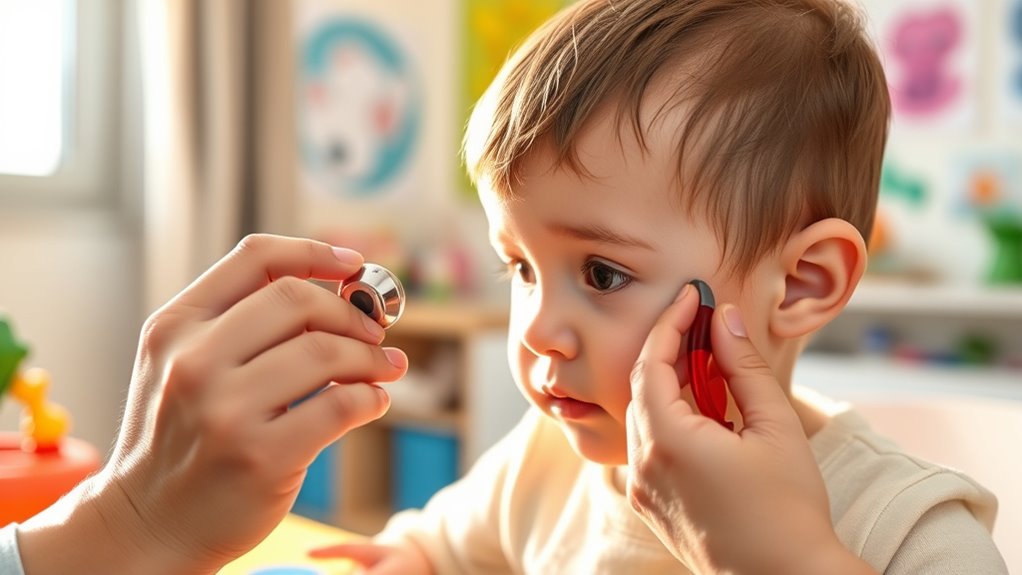
How can you tell if your child’s speech and language skills are developing normally? Typically, children reach certain milestones at specific ages. By observing their ability to respond, speak, and understand, you can gauge progress. Here’s a quick overview:
| Age Range | Typical Milestone | What to Watch For |
|---|---|---|
| 6-12 months | Babbling, simple sounds | Responds to name, gestures |
| 12-24 months | First words, combining two words | Uses words for familiar objects |
| 2-3 years | Short sentences, vocabulary growth | Follows simple instructions |
| 3-4 years | Complex sentences, clear speech | Engages in conversations |
If your child’s development differs from these milestones or seems delayed, consider consulting a professional. Early intervention supports healthy speech and language growth. Additionally, monitoring cybersecurity measures can help protect your child’s online safety as they begin to communicate more digitally.
Tracking Hearing Development Through Toddler Years
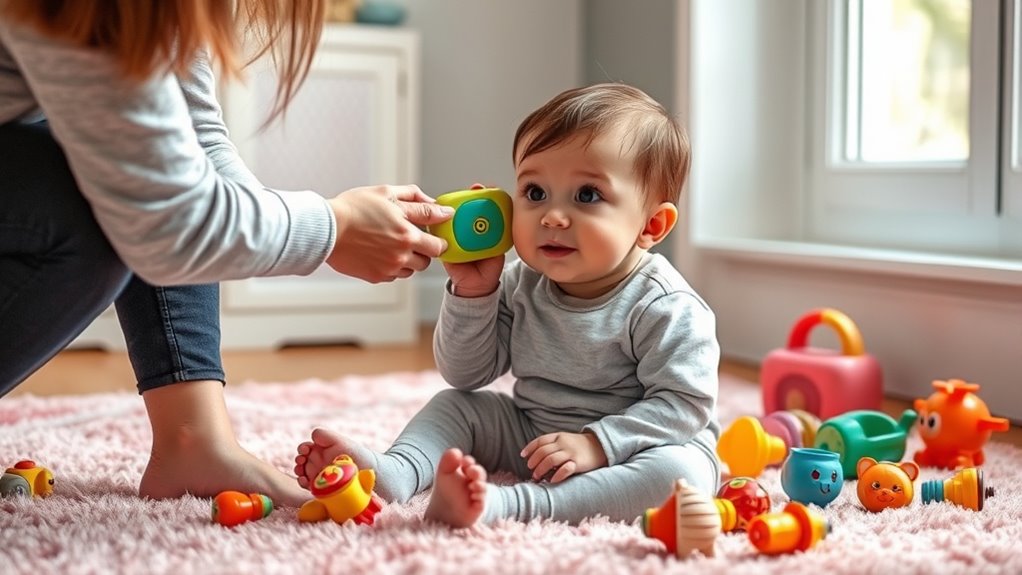
Monitoring your child’s hearing development during the toddler years is vital to guarantee they’re responding to sounds appropriately and gaining language skills. At this stage, observe if they turn toward familiar voices or sounds, like a doorbell or their name. Notice if they follow simple directions, such as “come here” or “give me the toy.” Regularly engage in conversations and listen for their responses. Keep track of their ability to recognize different sounds and speech in various environments. Use simple hearing assessments recommended by your pediatrician or audiologist during checkups. Consistent monitoring helps identify any concerns early, ensuring your child receives timely support. Remember, toddlers’ hearing can fluctuate, so ongoing observation is key to supporting healthy auditory development. Additionally, understanding hearing milestones can help you gauge whether your child’s hearing is developing typically.
Signs of Hearing Concerns in Preschool Children
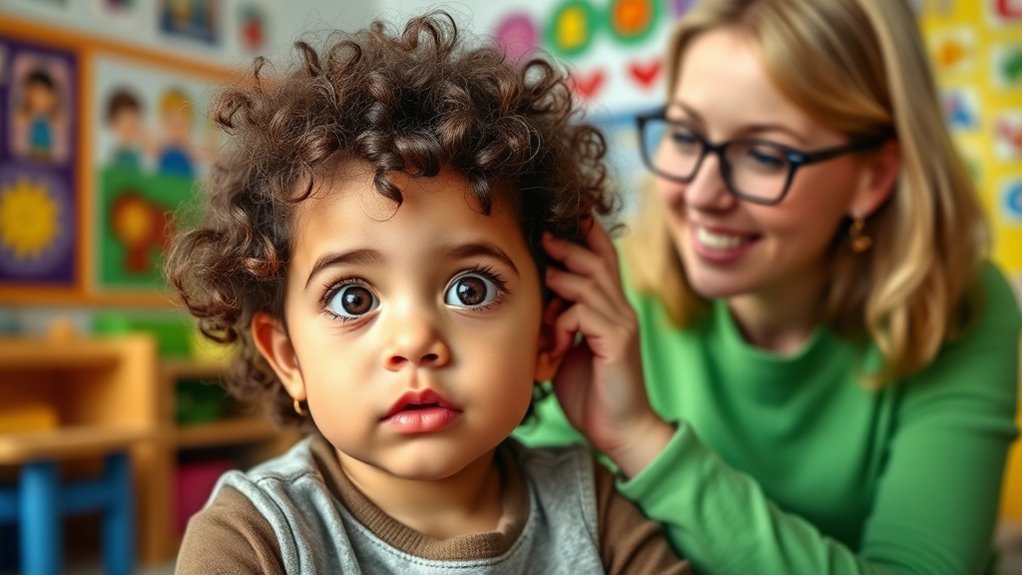
Early signs of hearing concerns in preschool children can often be subtle, but paying close attention is essential. Look for behaviors such as frequently asking to repeat instructions, missing everyday sounds, or seeming inattentive during conversations. Your child’s responses may be delayed or inconsistent, especially in noisy environments. Watch for difficulty following simple directions or a lack of response to their name. Here’s a quick guide:
| Sign to Watch For | What It Looks Like |
|---|---|
| Hearing delays | Not responding or delayed response to sounds |
| Speech issues | Limited vocabulary or unclear speech |
| Behavioral cues | Frustration or withdrawal during social interactions |
| Attention problems | Struggling to focus or follow along |
Recognizing these signs early can lead to timely evaluation and support, ensuring your child’s hearing health. Being aware of these hearing milestones can help parents identify potential issues sooner.
Common Causes of Hearing Loss in Children

Many factors can cause hearing loss in children, starting with congenital conditions they’re born with. Infections and illnesses can also affect hearing if not treated promptly. Additionally, exposure to loud noises puts kids at risk for future hearing problems. Using protective measures such as hearing protection devices during noisy activities can help prevent noise-induced hearing loss.
Congenital Conditions Impact
Congenital conditions are a pivotal cause of hearing loss in children, often present at birth and affecting their ability to develop speech and language skills. These conditions can result from genetic factors, such as inherited syndromes or mutations, or from structural abnormalities in the ear. For example, some children are born with malformed cochleas or auditory nerves, making sound perception difficult. Other congenital issues include syndromes like Usher or Waardenburg, which involve multiple systems but also impact hearing. Early identification of these conditions is essential because timely intervention can improve communication outcomes. Regular screenings and family history assessments help detect congenital hearing loss early, enabling you to seek appropriate support and resources to support your child’s development. Recognizing trust issues early can also significantly influence the success of intervention strategies.
Infections and Illnesses
Did you know that infections and illnesses are common causes of hearing loss in children? These health issues can damage the ear structures or affect the auditory nerve, leading to temporary or permanent hearing issues. Recognizing and treating infections early can prevent long-term damage. Some key infections include:
- Otitis media (middle ear infection)
- Meningitis
- Measles
- Mumps
- Chickenpox
These illnesses can cause fluid buildup, inflammation, or nerve damage, disrupting normal hearing. Children with frequent or severe infections are at higher risk. It’s important to monitor hearing, especially after illness. Prompt medical attention and appropriate treatment can reduce the likelihood of lasting hearing problems and support your child’s speech and language development. Additionally, understanding the role of AI in Education can help tailor early intervention strategies for children with hearing issues.
Noise Exposure Risks
Exposure to loud noises is a leading cause of hearing loss in children, especially when they are frequently or consistently exposed to high-volume sounds. Activities like listening to loud music, attending concerts, or using earbuds at high volumes can damage their delicate hearing. To help you understand common risks, here’s a quick overview:
| Situation | Risk Level |
|---|---|
| Headphones at maximum volume | High |
| Loud concerts or events | High |
| Power tools or machinery | High |
| Regular exposure to loud environments | Moderate |
Always monitor your child’s noise exposure and encourage safe listening habits. Protecting their hearing now prevents long-term issues later.
When and How to Test Your Child’s Hearing
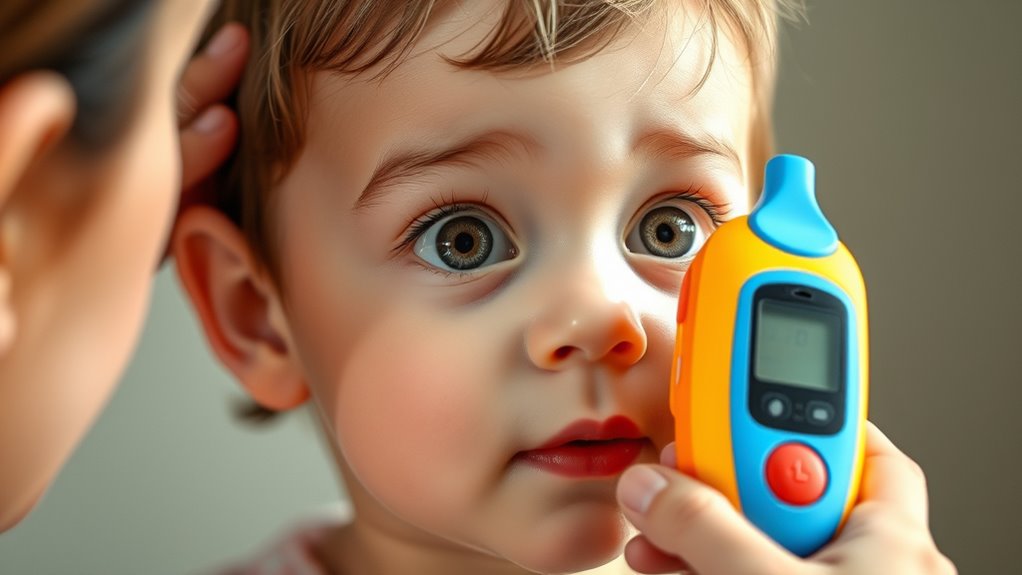
Wondering when to have your child’s hearing tested? Early detection is vital, so consider testing if your child shows signs of hearing issues or if they miss developmental milestones. Typically, hearing screenings are recommended:
- During routine pediatric checkups, starting at age 3 months
- If your child experiences frequent ear infections
- When they don’t respond to loud sounds or their name
- If they have a family history of hearing loss
- When you notice speech delays or unclear speech
Testing methods vary by age and development. Infants often undergo otoacoustic emissions (OAE) testing, while older children may complete audiometry or play-based hearing tests. Consulting an audiologist ensures accurate assessment and early intervention if needed.
Strategies to Support Healthy Hearing in Kids
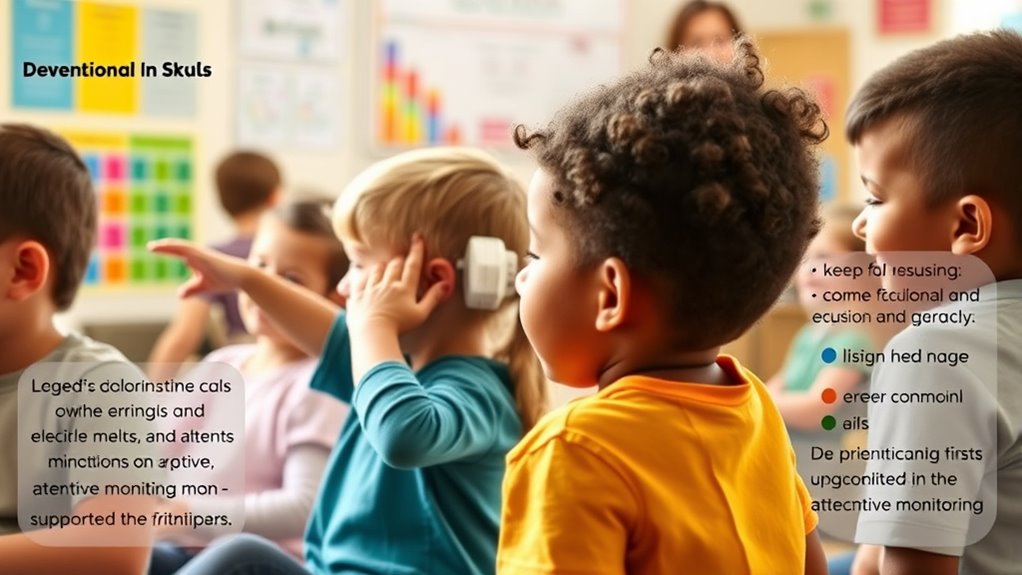
Supporting your child’s healthy hearing starts with simple everyday strategies that can make a big difference. Keep noise levels moderate, especially during play and screen time, to prevent damage. Encourage your child to take regular breaks from loud environments, like concerts or noisy outings. Maintain a clutter-free space to reduce the risk of accidents involving loud or sharp objects. Here’s a quick guide:
| Environment | Action | Benefit |
|---|---|---|
| Loud settings | Use ear protection (earplugs, muffs) | Protects against noise damage |
| Screen time | Limit exposure and promote quiet activities | Prevents overstimulation |
| Play areas | Ensure safe, quiet zones for rest | Reduces stress and fatigue |
These small steps can help preserve your child’s hearing health long-term. Additionally, understanding age-related milestones in hearing development can aid in early detection of potential issues.
Tips for Parents to Monitor and Promote Hearing Well-being
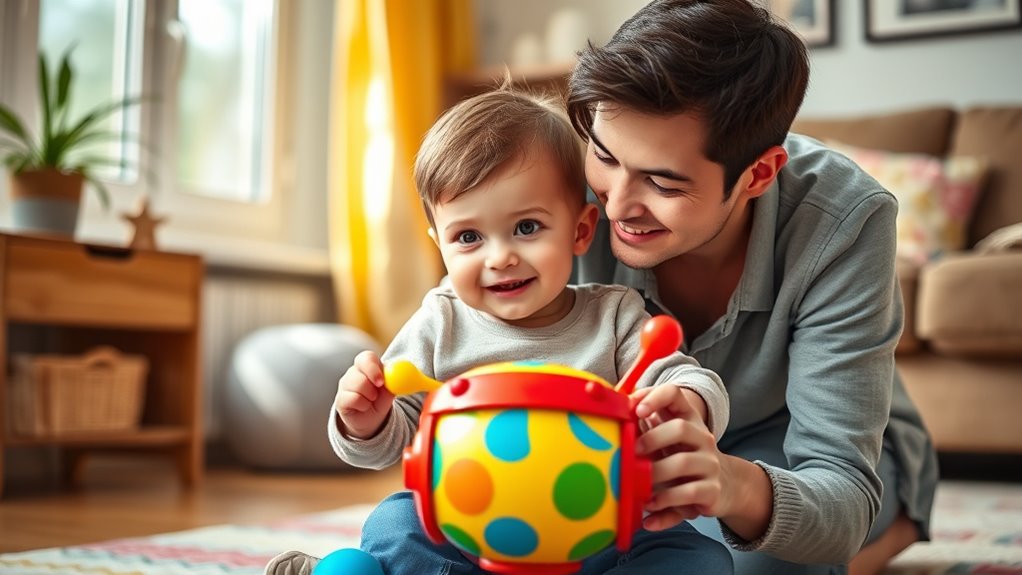
To guarantee your child’s hearing stays healthy, it’s important to actively monitor their listening habits and promptly address any signs of difficulty. Keep an eye out for changes in their speech, frequent requests for repetition, or withdrawal from noisy environments. Regularly check their response to sounds during play or conversations. Encourage open communication about any discomfort or hearing concerns. You can also:
- Limit exposure to loud noises and use hearing protection when needed
- Schedule routine hearing screenings with a professional
- Observe their reactions to different sounds and volumes
- Educate them about safe listening practices
- Create a quiet, calm environment for better auditory development
- Be aware of AI vulnerabilities that could impact technology used in hearing devices or assessments
Staying vigilant helps catch issues early, ensuring your child’s hearing remains healthy and functional for years to come.
Frequently Asked Questions
How Can I Differentiate Between Hearing Loss and Language Delays?
You might wonder if your child’s communication issues are due to hearing loss or language delays. To tell the difference, observe their response to sounds—if they don’t startle or turn toward familiar noises, hearing loss could be involved. Language delays often show as slow vocabulary growth or difficulty forming sentences, even when hearing is normal. Consulting a pediatric audiologist or speech-language pathologist can provide clarity and appropriate intervention.
Are There Specific Toys or Activities That Promote Hearing Health?
Think of your child’s hearing like a delicate garden needing nurturing. You can promote hearing health with toys that encourage listening and sound exploration, like musical instruments, sound puzzles, or noise-making toys. Activities such as singing, reading aloud, and playing with rhythm instruments help develop auditory skills. Keep the environment rich in varied sounds, and regularly check in with a pediatric audiologist to guarantee their hearing stays healthy and strong.
What Are the Latest Advancements in Pediatric Hearing Tests?
You’re curious about the latest advancements in pediatric hearing tests. Recent innovations include portable, frequency-specific devices that provide quicker and more accurate results, even in non-clinical settings. Additionally, automated testing with artificial intelligence helps identify hearing issues early, streamlining diagnosis. These advancements enable you to detect hearing problems sooner, ensuring your child gets timely intervention. The hope is to make testing more accessible, comfortable, and precise for every child.
How Does Ear Infection Impact Long-Term Hearing Development?
When you ask about how ear infections impact long-term hearing development, you’re questioning the lasting effects of these common childhood issues. Ear infections can cause temporary hearing loss, disrupt speech development, and lead to balance problems. Recurrent infections increase the risk of permanent damage, impacting your child’s ability to hear clearly, learn effectively, and communicate confidently. Early detection and treatment are vital to prevent these long-term consequences and promote healthy hearing growth.
When Should I Consider a Specialist for My Child’s Hearing Concerns?
If you notice your child struggles to respond to sounds, follow speech development closely, or if they seem to have difficulty hearing in noisy environments, it’s time to see a specialist. Don’t wait if your child shows signs of persistent ear infections, delayed speech, or inconsistent hearing responses. Early intervention can make a big difference, so trust your instincts and seek professional advice promptly when concerns arise.
Conclusion
Just like a delicate garden needs careful tending, your child’s hearing health requires your ongoing attention. By recognizing early milestones and red flags, you can guarantee their world remains vibrant and full of sound. Remember, every whisper and giggle is a precious gift—nurture it. With your vigilance and love, you’ll help your child thrive, turning life’s quiet moments into beautiful symphonies of growth and joy.
